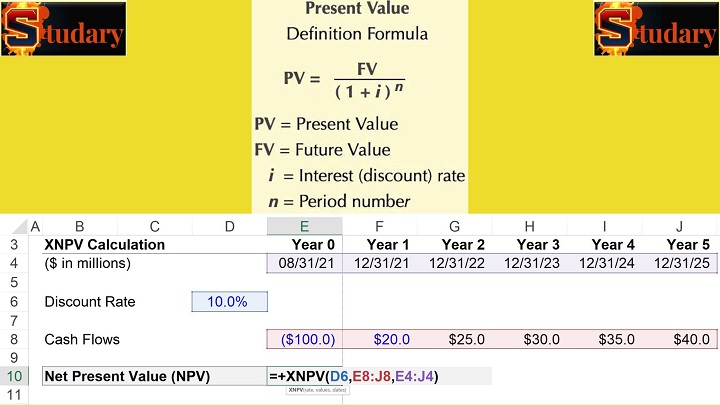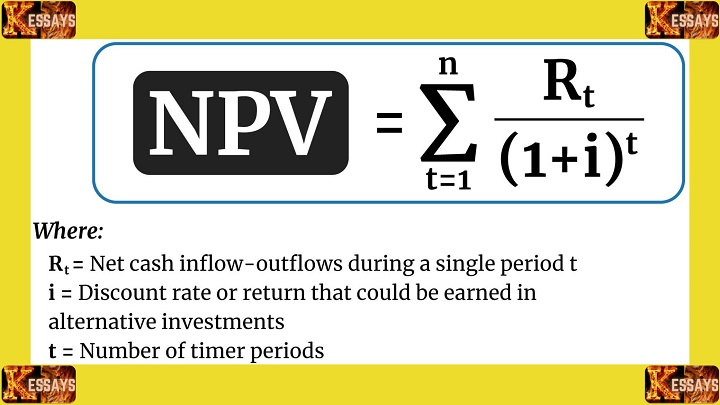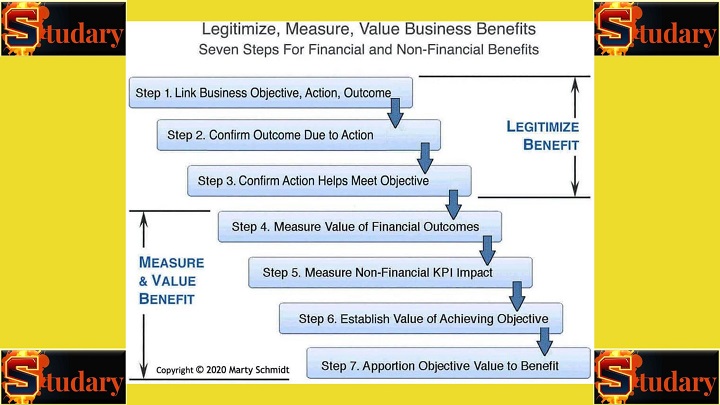Introduction
When assessing investment opportunities, organizations often rely on financial metrics such as Net Present Value (NPV) to make informed decisions. However, in addition to financial considerations, non-financial factors also play a vital role in investment evaluations. This comprehensive article explores the significance of non-financial factors in NPV calculations, offering expert insights and examples to enhance understanding and decision-making.
I. Understanding NPV Calculations
Net Present Value (NPV) is a widely used financial metric in investment analysis. It measures the profitability of an investment by comparing the present value of cash inflows with the present value of cash outflows. A positive NPV indicates that an investment is expected to generate more value than the initial cost, while a negative NPV suggests potential losses.

II. Non-Financial Factors in Investment Evaluations
-
Market Demand and Trends
Assessing market demand and keeping abreast of industry trends are crucial non-financial factors in NPV calculations. Understanding customer preferences, market dynamics, and potential shifts in demand can significantly impact the projected cash inflows and the long-term success of an investment.
While market demand and trends are important non-financial factors in NPV calculations, they are typically not quantitatively measured like financial metrics. However, incorporating market demand and trends into NPV calculations can be done through qualitative assessments and scenario analysis. Let's consider an example:
Example
A company is evaluating the potential investment in a new mobile application. The initial investment cost for developing and launching the app is estimated at $500,000. To assess the impact of market demand and trends, the company conducts market research and gathers qualitative data on consumer preferences, industry trends, and competitive landscape. Based on this information, they estimate three scenarios:
Scenario 1
Conservative Demand In this scenario, the company expects moderate market demand for the mobile application. They estimate an annual cash inflow of $100,000 for the first three years, followed by a gradual decline of 10% per year.
Scenario 2
Moderate Demand In this scenario, the company anticipates a stronger
market demand for the mobile application. They estimate an annual cash inflow of $150,000 for the first three years, followed by a gradual decline of 5% per year.
Scenario 3
High Demand In this scenario, the company predicts a high market demand for the mobile application. They estimate an annual cash inflow of $200,000 for the first three years, followed by a gradual decline of 3% per year.
Next, the company incorporates the estimated cash inflows from each scenario into the NPV calculation using an appropriate discount rate (let's assume 10%):

NPV for Scenario 1
-$500,000 + ($100,000 / (1+0.10)^1) + ($100,000 / (1+0.10)^2) + ($100,000 / (1+0.10)^3) + ($90,000 / (1+0.10)^4) + ($81,000 / (1+0.10)^5)
NPV for Scenario 2
-$500,000 + ($150,000 / (1+0.10)^1) + ($150,000 / (1+0.10)^2) + ($150,000 / (1+0.10)^3) + ($142,500 / (1+0.10)^4) + ($135,375 / (1+0.10)^5)
NPV for Scenario 3
-$500,000 + ($200,000 / (1+0.10)^1) + ($200,000 / (1+0.10)^2) + ($200,000 / (1+0.10)^3) + ($194,000 / (1+0.10)^4) + ($188,180 / (1+0.10)^5)
By calculating the NPV for each scenario, the company can assess the potential financial returns under different market demand conditions. This information can help decision-makers evaluate the investment's risk and profitability in light of market demand and trends.
It is important to note that the examples provided are simplified for illustration purposes. In real-world scenarios, market demand analysis and scenario assessments involve more detailed research, data collection, and expert judgment to accurately estimate cash inflows and their impact on NPV calculations.
-
Technological Advancements
In today's fast-paced
business environment, technological advancements play a critical role in investment decisions. Evaluating the impact of emerging technologies, digital transformation, and automation can help determine the competitiveness and future growth potential of an investment.
Example: When considering investing in a manufacturing facility, analyzing technological advancements such as robotics, artificial intelligence, and advanced automation systems can provide insights into potential efficiency gains, cost savings, and competitive advantages.
-
Environmental and Social Impact
Considering the environmental and social impact of investments is increasingly important for organizations aiming to align their strategies with sustainability goals and ethical considerations. Non-financial factors, such as carbon footprint, resource consumption, and social responsibility, can influence investment decisions and long-term value creation.
Example: Before investing in a construction project, evaluating the environmental impact, sustainability practices, and community engagement initiatives can contribute to a more comprehensive assessment of the investment's viability and its alignment with corporate values.
III. Incorporating Non-Financial Factors in NPV Calculations
-
Qualitative Analysis
To account for non-financial factors, qualitative analysis techniques can be applied alongside traditional financial analysis methods. This involves assessing subjective aspects such as risk management, strategic fit, brand reputation, and stakeholder relationships.
Example
When evaluating a potential merger or acquisition, financial metrics alone may not capture the cultural fit or potential synergies. Qualitative analysis can help assess factors such as organizational culture, leadership compatibility, and brand reputation, providing a more holistic perspective on the investment's potential success.
Qualitative analysis in the context of non-financial factors does not involve calculations in the traditional sense. Rather, it focuses on subjective assessments and evaluations. Let's consider an example to understand how qualitative analysis can be used to assess non-financial factors:
Example
A company is considering a potential merger with another firm. While financial analysis provides insights into the profitability and financial performance of both companies, qualitative analysis is necessary to evaluate non-financial factors that can significantly impact the success of the merger. Here are some key qualitative factors that can be assessed:
- Organizational Culture: The compatibility of organizational cultures is crucial for a successful merger. Assessing the alignment of values, management styles, and employee morale can be done through interviews, surveys, and observations.
- Leadership Compatibility: Evaluating the compatibility of leadership styles, decision-making processes, and communication approaches is important. Interviews and discussions with key executives can provide insights into the compatibility and potential challenges.
- Brand Reputation: Assessing the brand reputation of both companies is vital. This can be done through market research, customer surveys, and analysis of media coverage to understand how customers perceive the brands and the potential impact on the combined entity.
- Stakeholder Relationships: Examining the relationships with key stakeholders, such as customers, suppliers, and regulatory bodies, is essential. Interviews and feedback sessions with stakeholders can shed light on the strength and nature of these relationships.
To evaluate these qualitative factors, a structured approach can be followed. For each factor, a rating or score can be assigned based on the assessment. For example, a rating scale of 1-5 can be used, with 1 indicating poor alignment or compatibility and 5 indicating strong alignment or compatibility.
Once the assessments are completed, the qualitative factors can be combined with the financial analysis to form a more comprehensive evaluation of the merger opportunity. Decision-makers can consider the overall qualitative assessment alongside the quantitative financial analysis to make a well-informed decision.
It is important to note that qualitative analysis involves subjective judgments and relies on the expertise and experience of those conducting the evaluation. Therefore, it is essential to involve relevant stakeholders and experts to ensure a comprehensive and accurate assessment of the non-financial factors.
-
Scenario Analysis
Scenario analysis allows decision-makers to evaluate the impact of non-financial factors by considering different possible outcomes and their associated probabilities. By incorporating various scenarios, organizations can assess the robustness of an investment and make more informed decisions.

Example
When evaluating an infrastructure project, scenario analysis can help assess the impact of non-financial factors such as regulatory changes, geopolitical risks, and community acceptance. By considering multiple scenarios, decision-makers gain insights into the project's resilience and adaptability to changing circumstances.
Scenario analysis is a powerful tool that enables decision-makers to explore the potential outcomes of an investment under different circumstances. By considering various scenarios, organizations can incorporate non-financial factors into their evaluation. Here's an example that demonstrates the application of scenario analysis in assessing non-financial factors:
Example
A company is considering investing in a renewable energy project, specifically a wind farm. They anticipate
cash inflows from selling electricity generated by the wind turbines. However, they are aware that non-financial factors such as environmental regulations, public acceptance, and weather patterns can significantly impact the project's success.
To conduct a scenario analysis, the company identifies three scenarios:
Scenario 1
Favorable Conditions In this scenario, the company assumes that the project will face minimal regulatory hurdles, strong public support, and optimal wind conditions. They estimate the annual cash inflows to be $1 million for the first five years, followed by a gradual decline of 5% per year.
Scenario 2
Moderate Conditions In this scenario, the company assumes that the project will face moderate regulatory challenges, moderate public acceptance, and average wind conditions. They estimate the annual cash inflows to be $800,000 for the first five years, followed by a gradual decline of 8% per year.
Scenario 3
Challenging Conditions In this scenario, the company assumes that the project will face stringent regulatory requirements, limited public acceptance, and suboptimal wind conditions. They estimate the
annual cash inflows to be $500,000 for the first five years, followed by a gradual decline of 10% per year.
Next, the company incorporates the estimated cash inflows from each scenario into the net present value (NPV) calculation using an appropriate discount rate. Let's assume a discount rate of 8%:
NPV for Scenario 1=
-$10,000,000 + ($1,000,000 / (1 + 0.08)^1) + ($1,000,000 / (1 + 0.08)^2) + ($1,000,000 / (1 + 0.08)^3) + ($1,000,000 / (1 + 0.08)^4) + ($950,000 / (1 + 0.08)^5)
NPV for Scenario 2 =
-$10,000,000 + ($800,000 / (1 + 0.08)^1) + ($800,000 / (1 + 0.08)^2) + ($800,000 / (1 + 0.08)^3) + ($800,000 / (1 + 0.08)^4) + ($736,000 / (1 + 0.08)^5)
NPV for Scenario 3 =
-$10,000,000 + ($500,000 / (1 + 0.08)^1) + ($500,000 / (1 + 0.08)^2) + ($500,000 / (1 + 0.08)^3) + ($500,000 / (1 + 0.08)^4) + ($460,000 / (1 + 0.08)^5)
By calculating the NPV for each scenario, the company can evaluate the financial feasibility of the investment under different non-financial conditions. Scenario analysis helps decision-makers understand the potential risks and rewards associated with the investment and enables them to make informed decisions considering a range of possible outcomes.
It is important to note that scenario analysis requires careful consideration of factors that can impact the investment. The scenarios should be realistic and based on thorough research, expert opinions, and
historical data. By exploring multiple scenarios, decision-makers can gain a more comprehensive understanding of the investment's potential and make better-informed choices.
-
Stakeholder Engagement
Engaging relevant stakeholders in the investment evaluation process is crucial for considering non-financial factors. Stakeholders may include employees, customers, local communities, regulatory bodies, and advocacy groups. By gathering input and incorporating diverse perspectives, organizations can ensure a comprehensive assessment of non-financial impacts.
Example: Before investing in a new product development project, involving potential customers through surveys or focus groups can provide insights into non-financial factors such as user experience, product design, and market acceptance.

IV. Balancing Financial and Non-Financial Factors
Achieving a balance between financial and non-financial factors is essential for
effective investment decision-making. While financial metrics like NPV are crucial for assessing the economic feasibility of an investment, incorporating non-financial factors enhances the overall evaluation process and leads to more comprehensive and informed decisions.
Example
A company considering an investment project must evaluate both the financial attractiveness (NPV, ROI) and non-financial factors (market demand, technological advancements, environmental impact) to determine if the investment aligns with the organization's strategic goals and values.
When it comes to balancing financial and non-financial factors, calculations are not always applicable to non-financial considerations. However, let's explore an example that illustrates the balance between financial and non-financial factors in investment decision-making:
Example
A company is evaluating an investment project to expand its manufacturing capabilities. They have estimated the initial investment cost to be $2 million, with an expected cash inflow of $500,000 per year for the next five years. The company calculates the NPV of the investment using a discount rate of 10% to assess the financial feasibility:
NPV = -Initial Investment + (Cash Inflow Year 1 / (1 + Discount Rate)^1) + (Cash Inflow Year 2 / (1 +
Discount Rate)^2) + ... + (Cash Inflow Year 5 / (1 + Discount Rate)^5)
NPV = -$2,000,000 + ($500,000 / (1 + 0.10)^1) + ($500,000 / (1 + 0.10)^2) + ($500,000 / (1 + 0.10)^3) + ($500,000 / (1 + 0.10)^4) + ($500,000 / (1 + 0.10)^5)
After calculating the NPV, let's assume it turns out to be positive, indicating a financially viable project with a positive net value. However, financial metrics alone do not provide a complete picture. The company also needs to consider non-financial factors to make an informed decision. Here are some examples of non-financial factors that can be taken into account:
- Environmental Impact: Assessing the potential environmental impact of the expansion project, such as energy consumption, waste generation, and carbon emissions. The company can calculate the estimated reduction in carbon emissions or compare it to industry benchmarks to evaluate the environmental benefits.
- Social Responsibility: Evaluating the social impact of the investment, such as job creation, community development, or contribution to sustainable practices. This can involve conducting social impact assessments, stakeholder consultations, or measuring the project's alignment with corporate social responsibility goals.
- Strategic Fit: Analyzing the alignment of the investment project with the company's long-term strategic goals. This involves considering factors like market positioning, competitive advantage, and the potential to expand into new markets or product lines.
To balance financial and non-financial factors, decision-makers assign weights or scores to each factor based on their importance. For instance, they may assign a higher weight to financial metrics like NPV (e.g., 70%) and allocate the remaining weight (e.g., 30%) to non-financial factors.
In the given example, the company evaluates the non-financial factors based on their
strategic objectives and assigns an overall score. They may rate the environmental impact as 8 out of 10, social responsibility as 7 out of 10, and strategic fit as 9 out of 10. These scores are subjective and depend on the specific context and priorities of the company.
By considering both financial and non-financial factors and assigning appropriate weights or scores, the decision-makers can make a well-informed investment decision. The balanced evaluation ensures that the investment not only provides financial returns but also aligns with the organization's strategic objectives and values.

Conclusion
Non-financial factors play a critical role in investment evaluations alongside traditional financial metrics. By considering market demand, technological advancements, environmental and social impact, organizations can achieve a more holistic understanding of investment opportunities. Incorporating non-financial factors through
qualitative analysis, scenario analysis, and stakeholder engagement enhances the decision-making process and helps align investments with long-term goals and values. Balancing financial and non-financial considerations enables organizations to make well-informed investment decisions that maximize both financial returns and broader societal impact.





Comments are closed!